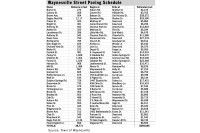The Naturalist's Corner: Buteo jamaicensis
A red-tail by any other name and there are several “named” red-tails. But I dare say for we sons and daughters of the South, simply the word hawk conjures up mental images of Buteo jamaicensis either scanning its surroundings from atop a telephone pole, a high snag or a fence post. And most can remember hearing a piercing scream and turning upward to see this avian god soaring overhead on broad wings with flaming tail trailing.
The Naturalist's Corner: Windy City peregrines
My bride and I spent a few days in Chicago last week. She was there for a business seminar and I was there for moral support. But, alas, I also had work to do so after walking with her to the 737 Building on N. Michigan Ave. I returned to our room and began recording data from this year’s Forest Service bird points. Our room was on the 26th floor and with the curtains open I had a view of the Chicago skyline. I sat there, entering data and watching it rain. I posted a photo of that rainy day scene on Facebook. Friend and Facebook friend, Janice Irwin, asked if I was looking for peregrines. I said sure and spidermen and went back to my work.
The Naturalist's Corner: Birding daze
The six weeks from May 1 to June 15 are always a busy time for me. That is the window for my annual Forest Service bird survey. I have more than 200 points spread across the Nantahala and Pisgah national forests from the Hiwassee Dam to Yellow Mountain, to Brevard, to Mt. Mitchell and Roan Mountain and points in between. This year because of all the rain in early May and then the passing of my brother in late May, that window was even more constricted.
Year of the bird: Killdeer nest prompts planning shuffle for Greening Up The Mountains
Every year, Sylva’s population quadruples on the last Saturday in April as more than 10,000 people flock to the tiny town for Greening Up the Mountains, a long-running festival featuring live music on two stages, a 5K run and more than 125 vendors offering crafts, food and information about local nonprofits.
Planning the event is a year-round endeavor for town staff, and as this year’s April 27 date drew closer, all the ducks seemed to be sorting themselves into their respective rows — until a different kind of bird threw a wrench in the plans.
The Naturalist's Corner: Bated breath
I am sure I’m not the only one hoping the Lake Junaluska eagles are successful this nesting season. It seems, by all appearances, we should have an answer in just a few short weeks.
The Naturalist's Corner: Lake Junaluska eagles – do over?
It appears the eagles that nested unsuccessfully last year at Lake Junaluska are back for another go at it. There have been reports of a pair doing a bit of remodeling at the nest and a pair (presumably the same one) has been seen interacting at the nest and in flight — both good signs of pair bonding.
The Naturalist's Corner: Live and die by Lake J
Jan. 4, 2019 was a dreary day. It was more than that; it was a dreary Balsam Christmas Bird Count day. We have generally, since its inception 17 years ago, scheduled our Balsam CBC during the last count weekend. We did so because we have section leaders and others who also participate in other established area counts. Audubon’s count period ended on Jan. 4 this year so we didn’t really have a weather makeup date, besides most CBCs run rain or shine on the appointed date.
The Naturalist's Corner: Flocking together
Birding buddy and former subcontractor for my Forest Service point-count survey, Kirk Gardner, was in town for the holidays and managed to cobble together a group of birding buddies for a bit of birding.
The Naturalist's Corner: Eye on the lake
Lake Junaluska is an amazing resource. It is home to the Lake Junaluska Conference and Retreat Center, the World Methodist Council and Intentional Growth Center and attracts visitors and guests from all around the world. Area residents flock to the wonderful walking trail for a little exercise and/or to simply enjoy the beauty. It is becoming a regular haunt for photographers. And the new boat landing has provided more access for fishermen.
Evening gosbeaks to make rare appearance
“Seen for the first time amid the snows of winter and against a background of darkling pines these strange and beautiful waifs of the northland seem somehow out of place, as would some rare and singular exotic plant blossoming in ... winter.” — Dr. Elliot Coues, Birds of North America (1925)
Head up bird watchers! According to a recent news release posted online at eBird — an excellent source of information sponsored by the Cornell Lab of Ornithology — advised that early “observations are hinting at the largest movement of Evening Grosbeaks in the Northeast in more than a decade.”





